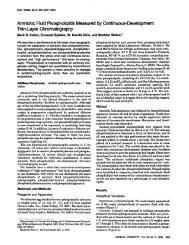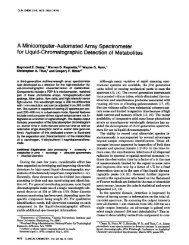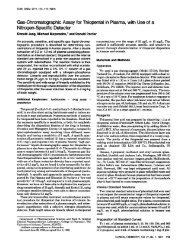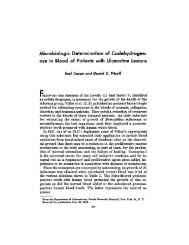Why isthe laboratory an afterthought for ... - Clinical Chemistry
Why isthe laboratory an afterthought for ... - Clinical Chemistry
Why isthe laboratory an afterthought for ... - Clinical Chemistry
Create successful ePaper yourself
Turn your PDF publications into a flip-book with our unique Google optimized e-Paper software.
<strong>Clinical</strong> Chernistiy 42:5<br />
813-816 (1996) Cinial <strong>Chemistry</strong><br />
Forum<br />
<strong>Why</strong><br />
is the <strong>laboratory</strong> <strong>an</strong> <strong>afterthought</strong> <strong>for</strong><br />
m<strong>an</strong>aged care org<strong>an</strong>izations?<br />
RODNEY<br />
VV. FORSMAN<br />
Market <strong>for</strong>ces have dramatically influenced the environment<br />
in which healthcare is delivered, but these ch<strong>an</strong>ges do<br />
not need to be interpreted negatively by conununity laboatori<strong>an</strong>s.<br />
Only total vertical integration of <strong>laboratory</strong> medicine<br />
c<strong>an</strong> control episode-of-care cost. Opportunities also<br />
exist <strong>for</strong> horizontal integration with community partners to<br />
provide geographical coverage <strong>an</strong>d to compete favorably <strong>for</strong><br />
m<strong>an</strong>aged care contracts. Lowering cost through “economies<br />
of scale” may apply to the procurement of supplies <strong>an</strong>d<br />
equipment, but the delivery of services must be considered<br />
in the context of their overall effect on episode-of-care cost.<br />
Laboratory services may make up 5% of a hospital’s budget<br />
but leverage 60 -70% of all critical decision-making such as<br />
admitt<strong>an</strong>ce, discharge, <strong>an</strong>d medication. Laboratory outreach<br />
c<strong>an</strong> help the medical center’s fin<strong>an</strong>cial stability by: (a)<br />
providing tests <strong>an</strong>d service that c<strong>an</strong> reduce or avoid a<br />
hospital stay; (b) using the additional volume of testing to<br />
distribute existing fixed costs <strong>an</strong>d lower unit cost; <strong>an</strong>d (c)<br />
adding revenue as a direct contribution to margin. To<br />
successfully compete <strong>for</strong> contracted m<strong>an</strong>aged care services,<br />
the <strong>laboratory</strong> must network with other providers to demonstrate<br />
comprehensive access <strong>an</strong>d capacity. Community<br />
hospital laboratories per<strong>for</strong>m 50% of all <strong>laboratory</strong> tests in<br />
this country <strong>an</strong>d have adequate excess capacity to fulfill the<br />
remaining community needs.<br />
INDEXING TERMS: episode-of-care costs #{149} economies<br />
of integration<br />
#{149} risk sharing, commodity brokers #{149} value<br />
Over the last several years I have traveled throughout the<br />
country to meet with laboratori<strong>an</strong>s, hospital chief executive<br />
officers (CEOs), <strong>an</strong>d administrators, as well as health pl<strong>an</strong><br />
executives. I have learned from those conversations much about<br />
what is right <strong>an</strong>d what is wrong with our systems today. These<br />
observations are, of course, <strong>an</strong>ecdotal, <strong>an</strong>d the plural of <strong>an</strong>ecdote<br />
is not data. It remains <strong>for</strong> all of us to develop the hypotheses <strong>an</strong>d<br />
protocols <strong>an</strong>d to document the true value of <strong>laboratory</strong> medicine<br />
in the evolving m<strong>an</strong>aged care environment. However, those of<br />
Mayo Clinic, 200 1st St. SW, Rochester, MN 55905. Fax 507-284-4542.<br />
Received November 28, 1995; accepted February 8, 1996.<br />
us who m<strong>an</strong>age community-based laboratories need to select <strong>an</strong><br />
appropriate course of action <strong>an</strong>d move decisively now to survive<br />
long enough to collect these data.<br />
The Evolution of M<strong>an</strong>aged Care<br />
It would be wonderful if outcomes m<strong>an</strong>agement, continuous<br />
quality improvement, measurable value, <strong>an</strong>d true patient satisfaction<br />
were paramount in everyone’s mind, <strong>for</strong> that is what we<br />
as healthcare providers wish to deliver <strong>an</strong>d what well-in<strong>for</strong>med<br />
m<strong>an</strong>aged care org<strong>an</strong>izations w<strong>an</strong>t. Un<strong>for</strong>tunately, m<strong>an</strong>y proprietary<br />
m<strong>an</strong>aged care pl<strong>an</strong>s <strong>an</strong>d purchasers concern themselves<br />
only with price. This is particularly evident in the Cali<strong>for</strong>nia<br />
market today.<br />
The definition of m<strong>an</strong>aged care <strong>for</strong> Mayo Medical Center is<br />
as follows: appropriate care, delivered at <strong>an</strong> appropriate time, in<br />
the appropriate place, cost-effectively, with fin<strong>an</strong>cial incentives<br />
to the patient, <strong>an</strong>d with m<strong>an</strong>agement controls. The same<br />
definition presented by a m<strong>an</strong>aged care pl<strong>an</strong> is very often<br />
sprinkled throughout with the words “lower price.” As healthcare<br />
providers, should we charge lower prices or, instead, deliver<br />
care at lower cost? “M<strong>an</strong>aged care” is everything except that<br />
which is not m<strong>an</strong>aged care. In the alphabet soup of acronyms <strong>for</strong><br />
various pl<strong>an</strong>s available today, the import<strong>an</strong>t distinction is between<br />
providers of cost-effective care <strong>an</strong>d mere brokers of<br />
services purchased at lowest price.<br />
In our experience, <strong>laboratory</strong> costs contribute
814 Forsm<strong>an</strong>: M<strong>an</strong>aged care org<strong>an</strong>izations <strong>an</strong>d the <strong>laboratory</strong><br />
Low<br />
Pl<strong>an</strong><br />
Fee-For-Service<br />
Reimbursement<br />
Capltatlon<br />
Fig. 1. When risk is tr<strong>an</strong>sferred to providers, the health pl<strong>an</strong> <strong>an</strong>d<br />
patients bear littleor no risk (fullcapitation);moderate solutions<br />
should be devised with risk shared by all who influence utilization.<br />
movement from traditional fee-<strong>for</strong>-service to “at risk” compensation<br />
(capitation, withholds), whereby insurers hope to<br />
secure their profit margin while passing risk to providers (Fig.<br />
1). The potential profit may not be as large as in the past, but<br />
the risk is gone. Currently, those who broker healthcare take<br />
a signific<strong>an</strong>t percentage of the healthcare dollar. These profit<br />
margins will be difficult to sustain in a highly competitive<br />
market. Instead, the health pl<strong>an</strong>s try to secure a guar<strong>an</strong>teed<br />
profit of 8-9% while tr<strong>an</strong>sferring risk to providers. In<br />
Minneapolis <strong>an</strong>d St. Paul, a stage-four, or most highly<br />
evolved, market, the subscription rates <strong>for</strong> m<strong>an</strong>aged care<br />
products have dropped from $135 per member per month to<br />
$70. In this environment, shifting risk to the provider allows<br />
the insurer to eliminate administrative costs (e.g., <strong>an</strong> actuary<br />
to calculate risk); instead, the marketing staff simply needs to<br />
identify the current competitive rate necessary to capture<br />
market share [1]. Market share is, after all, the primary goal of<br />
the health pl<strong>an</strong>. I recently heard a provider contract negotiator<br />
in Ark<strong>an</strong>sas lament that if all the covered lives projected<br />
in the business pl<strong>an</strong>s of Little Rock insurers were summed,<br />
the state would need 50 million inhabit<strong>an</strong>ts! To meet fin<strong>an</strong>cial<br />
objectives, the health pl<strong>an</strong> must shift provider compensation<br />
from high-risk fee <strong>for</strong> service to low-risk capitation.<br />
Because providers take on the <strong>for</strong>mer role of the insurer <strong>an</strong>d<br />
bear subst<strong>an</strong>tial risk, they must be able to control risk by<br />
m<strong>an</strong>aging the physici<strong>an</strong>’s use of import<strong>an</strong>t tools, such as the<br />
<strong>laboratory</strong>, through disease m<strong>an</strong>agement strategies.<br />
To limit dem<strong>an</strong>d <strong>for</strong> unnecessary services, patients must<br />
share the risk. In a capitated environment, the health pl<strong>an</strong> bears<br />
no risk, the provider bears nearly all risk, <strong>an</strong>d, curiously, the<br />
patient incurs less risk, because the market has moved from a<br />
typical 20% copayment in a fee-<strong>for</strong>-service environment to a $5<br />
or $10 copayment in a capitated environment. Thus, even<br />
though our <strong>an</strong>nual price tag of $800 billion plus <strong>for</strong> healthcare<br />
is ever increasing, the out-of-pocket expense per individual has<br />
actually decreased. We incur less personal expense <strong>for</strong> healthcare,<br />
but wages fall <strong>an</strong>d product costs rise because of rising<br />
employer healthcare costs.<br />
Comniodity vs Service<br />
The healthcare broker looks at all the pieces of the pie <strong>an</strong>d says,<br />
“If we get the lowest bid on each piece, we c<strong>an</strong> assemble these<br />
commodities to obtain low-cost medicine.” Providers intuitively<br />
know that <strong>laboratory</strong> services are not a mere commodity. (In a<br />
commodity market, value is proportional to the inverse of price.<br />
If you obtain a commodity at a lower price, the value increases.)<br />
Although m<strong>an</strong>y health pl<strong>an</strong> executives underst<strong>an</strong>d the import<strong>an</strong>ce<br />
of vertical integration <strong>an</strong>d control of episode-of-care costs,<br />
negotiations <strong>for</strong> <strong>laboratory</strong> services often take place with lowerechelon<br />
contract officers who lack a broad perspective <strong>an</strong>d have<br />
parochial concerns about ratcheting down their departmental<br />
costs.<br />
We in the <strong>laboratory</strong> provide a service that includes consultative<br />
support <strong>an</strong>d in<strong>for</strong>mation m<strong>an</strong>agement. In a service industry,<br />
value is proportional to quality divided by cost. If we<br />
maintain quality <strong>an</strong>d lower costs, we have increased value. If we<br />
increase quality at the same cost, we have increased value. We<br />
c<strong>an</strong> also introduce time as <strong>an</strong> element of cost. Our Medical<br />
Director, Robert Kisabeth, suggests that the saying “time is<br />
money” diminishes the value of time. Time is first of all time.<br />
Time has its own value. As related to the <strong>laboratory</strong>, turnaround<br />
time is crucial to decision making, resulting in earlier discharge<br />
or diagnosis <strong>an</strong>d speeding the patient through the system. The<br />
<strong>laboratory</strong> must be a “gatekeeper,” in the popular phrase <strong>for</strong><br />
triaging patients in m<strong>an</strong>aged care-but we spell it “gait.” The<br />
<strong>laboratory</strong> c<strong>an</strong> contribute by increasing the pace of patients<br />
through the system.<br />
Economiesof Scale vs Economiesof Integration<br />
In the past, we derived savings from simple economies of scale.<br />
A higher volume of testing, consolidated at a central site,<br />
increased efficiency <strong>an</strong>d lowered unit costs. Those economies of<br />
scale have been exhausted. Further ef<strong>for</strong>ts to remove services<br />
from the medical center c<strong>an</strong> only diminish service <strong>an</strong>d adversely<br />
affect episode-of-care costs. If <strong>laboratory</strong> testing decreases, as it<br />
must in some areas, there will be even less opportunity <strong>for</strong><br />
economies of scale. But there remain tremendous opportunities<br />
<strong>for</strong> “economies of integration”: vertical integration within the<br />
medical center <strong>an</strong>d horizontal integration within the community.<br />
All too often, hospitals or medical centers compete with<br />
one <strong>an</strong>other, constructing medical office buildings to draw<br />
physici<strong>an</strong>s into their fold, buying up practices to garner patient<br />
referrals, <strong>an</strong>d otherwise competing <strong>for</strong> the delivery of identical<br />
services, leading to tremendous redund<strong>an</strong>cy. Testing per<strong>for</strong>med<br />
in the physici<strong>an</strong>’s office or outpatient setting is repeated <strong>for</strong> lack<br />
of a unified medical record system. I would estimate that<br />
15-25% of testing is redund<strong>an</strong>t due to lack of integration.<br />
Competition<br />
Who are the medical center’s true competitors? Paul M<strong>an</strong>go,<br />
Vice President <strong>an</strong>d chief operating officer of the Reference<br />
Laboratory Alli<strong>an</strong>ce in Pittsburgh, suggests that we need to<br />
underst<strong>an</strong>d three <strong>for</strong>ms of competition. We will always have<br />
horizontal competition from other medical centers. This is<br />
appropriate in a free marketplace <strong>an</strong>d improves quality. We also<br />
face a second, vertical competition from insurers, health main-
<strong>Clinical</strong> <strong>Chemistry</strong> 42, No. 5, 1996 815<br />
ten<strong>an</strong>ce org<strong>an</strong>izations, independent practice associations, <strong>an</strong>d<br />
preferred provider org<strong>an</strong>izations, who broker the services of the<br />
medical center <strong>an</strong>d amalgamate them into, supposedly, low-cost<br />
care while taking a margin off the top. To compete with the<br />
commodity brokers, medical centers need to develop their own<br />
m<strong>an</strong>aged care pl<strong>an</strong>s <strong>an</strong>d integrated delivery systems, not merely<br />
physici<strong>an</strong>-hospital org<strong>an</strong>izations. Un<strong>for</strong>tunately, this is yet <strong>an</strong>other<br />
reason why the <strong>laboratory</strong> is <strong>an</strong> <strong>afterthought</strong> <strong>for</strong> m<strong>an</strong>aged<br />
care. The m<strong>an</strong>aged care CEO underst<strong>an</strong>ds the power of vertical<br />
integration in the delivery of <strong>laboratory</strong> services <strong>an</strong>d would<br />
prefer to purchase from someone who is able to deliver that<br />
service. However, a strong medical center with a m<strong>an</strong>aged care<br />
offering competes directly <strong>for</strong> member subscriptions. So if your<br />
<strong>laboratory</strong> negotiates a contract with a large insurer, you have to<br />
recognize that your parent org<strong>an</strong>ization may be in direct<br />
competition with that same insurer. A third vector of competition<br />
is substitute competitors (e.g., surgicenters, cataract institutes,<br />
home health services, <strong>an</strong>d commercial laboratories), who<br />
take activities away from the medical center <strong>an</strong>d, in a bizarre<br />
arbitrage, also take margin through selectively favorable reimbursement<br />
[2]. Notice that all of these activities have one thing<br />
in common-favorable Current Procedual Terminology coding<br />
<strong>for</strong> reimbursement. Critical services that lack adequate reimbursement<br />
are left behind. At the same time, separating out<br />
these entrepreneurial activities frustrates the medical center’s<br />
ability to deliver integrated care.<br />
Strategic Pl<strong>an</strong>ning<br />
Robert Hattery, chairm<strong>an</strong> of the Board of Governors at Mayo,<br />
counsels those who would embrace ch<strong>an</strong>ge: “If the horse you are<br />
riding dies, get off.” During these times of great ch<strong>an</strong>ge <strong>an</strong>d<br />
challenge <strong>for</strong> the laboratori<strong>an</strong>, we must reengineer our services<br />
<strong>an</strong>d recoup the practice of <strong>laboratory</strong> medicine <strong>for</strong> our communities.<br />
The primary strategy I suggest is to follow a 25-year example<br />
from Mayo <strong>an</strong>d develop a community <strong>laboratory</strong> outreach<br />
program. Integral to that strategy is the philosophy that we are<br />
not selling a commodity based on price, but rather we sell<br />
service. Build service, sell service, <strong>an</strong>d deliver service, all the<br />
while enh<strong>an</strong>cing service in a continuous cycle. How does this<br />
contribute to the solution? Total internal test volume in a<br />
community <strong>laboratory</strong> will continue to decline to numbers<br />
commensurate with appropriate disease m<strong>an</strong>agement. We need,<br />
there<strong>for</strong>e, to offset that decreased volume with the volume<br />
available to us from physici<strong>an</strong>s’ offices. This contributes to the<br />
margin of our org<strong>an</strong>ization in three ways: (a) the existing fixed<br />
costs of pl<strong>an</strong>t <strong>an</strong>d equipment are spread over a larger base,<br />
adding test volume that lowers unit costs <strong>for</strong> all testing, (b)<br />
Enh<strong>an</strong>cement of test repertoire, providing improved turnaround,<br />
better service, shortened length of stay, <strong>an</strong>d more rapid<br />
diagnoses; <strong>an</strong>d (c) after variable costs are retrieved, revenue<br />
contributes directly to margin.<br />
In fee-<strong>for</strong>-service reimbursement, the more tests we do, the<br />
quicker we achieve a break-even point <strong>an</strong>d extract a contribution<br />
to margin. Under m<strong>an</strong>aged care, reimbursement will be received<br />
prospectively on a per-member-per-month basis, <strong>an</strong>d every cost<br />
we incur on that patient thereafter will diminish the contribution<br />
to margin. We must lower our unit costs now while the<br />
tr<strong>an</strong>sition is occurring if we are to be positioned strategically <strong>for</strong><br />
the future. When visiting community laboratories, I often see a<br />
very busy operation in the morning, but excess capacity during<br />
second <strong>an</strong>d third shifts. A prudent m<strong>an</strong>ager needs to fill that<br />
excess capacity <strong>an</strong>d keep people busy. Wouldn’t it be wonderful<br />
if a piece of equipment could wear out be<strong>for</strong>e it was obviated by<br />
new technology?<br />
The second strategy in preparing <strong>for</strong> m<strong>an</strong>aged care is<br />
horizontal integration. Currently, health pl<strong>an</strong>s believe that<br />
<strong>laboratory</strong> services must be bid <strong>for</strong> on a statewide or even<br />
national basis to obtain low price; however, healthcare is delivered<br />
locally, not nationally. Laboratory services are relev<strong>an</strong>t<br />
only in a community or regional context. Nonetheless, central<br />
administration of the contracting <strong>an</strong>d billing functions <strong>for</strong> broad<br />
geographical areas is <strong>an</strong> import<strong>an</strong>t marketing adv<strong>an</strong>tage when<br />
attempting to contract with payors. There<strong>for</strong>e we need to find<br />
other partners in the community. The keys to success in<br />
multiprovider networking are individual outreach development,<br />
vertical integration of <strong>laboratory</strong> medicine into the practice, <strong>an</strong>d<br />
finally horizontal integration <strong>an</strong>d contract negotiation. Further<br />
savings c<strong>an</strong> be achieved through sharing <strong>an</strong>d, ultimately, consolidating<br />
services where appropriate. This “consolidation in<br />
place” of community laboratories is now possible through<br />
available in<strong>for</strong>mation systems <strong>an</strong>d protection of “safe harbors”<br />
regulation [3].<br />
Community <strong>laboratory</strong> medicine is laboratori<strong>an</strong>s working<br />
with other community healthcare providers to deliver care to<br />
patients. Community laboratories solve problems, help make<br />
diagnoses, <strong>an</strong>d reduce inappropriate tests <strong>an</strong>d the attend<strong>an</strong>t<br />
downstream cost. I have seen a large <strong>laboratory</strong> in this country<br />
market a 64-test profile directly to patients, claiming this<br />
represented no additional cost to healthcare because the patient<br />
paid <strong>for</strong> it. Is itpossible that if you per<strong>for</strong>m 64 tests on even a<br />
healthy person, something is going to be abnormal? The<br />
medical center must pursue these abnormal results <strong>an</strong>d may be<br />
left with no reimbursement because of a capitated agreement.<br />
Inappropriate testing, as well as import<strong>an</strong>t testing that has been<br />
overlooked, causes tremendous downstream costs. If the pharmacy<br />
has a <strong>for</strong>mulary, why doesn’t the <strong>laboratory</strong> have prescribed<br />
tests, together with practice guidelines that ensure<br />
appropriate use? This would establish a st<strong>an</strong>dard of practice that<br />
precludes ordering tests that add cost but have no demonstrated<br />
value (e.g., CA 15-3 <strong>an</strong>d cathepsin D) [4].<br />
Continuous Improvement<br />
Consider how we might design a <strong>laboratory</strong> that goes beyond<br />
traditional me<strong>an</strong>s in contributing to outcomes m<strong>an</strong>agement of<br />
patients from cradle to grave. Almost every patient who accesses<br />
the system encounters the <strong>laboratory</strong>. <strong>Why</strong> c<strong>an</strong>’t the <strong>laboratory</strong><br />
create appropriate protocols to aid in the diagnosis of disease<br />
<strong>an</strong>d also to monitor compli<strong>an</strong>ce with treatment? Laboratory<br />
computer systems could alert providers that follow-up procedures<br />
have been missed. Phlebotomists could be trained to take<br />
blood pressures <strong>an</strong>d electrocardiograms, per<strong>for</strong>m rapid strep<br />
<strong>an</strong>alyses <strong>for</strong> outpatients, <strong>an</strong>d make inquiries as to patient satis-
816 Forsm<strong>an</strong>: M<strong>an</strong>aged care org<strong>an</strong>izations <strong>an</strong>d the <strong>laboratory</strong><br />
faction <strong>an</strong>d what might improve satisfaction during the episode<br />
of care.<br />
In the past, we concerned ourselves with revenue. In the<br />
future we must concern ourselves with quality <strong>an</strong>d episode-ofcare<br />
cost, not simply unit price. In the past we dealt with<br />
treatments; we must now underst<strong>an</strong>d entire processes. We need<br />
to get outside of our departments <strong>an</strong>d talk to others, e.g., in<br />
radiology, because what we do in the <strong>laboratory</strong> greatly affects<br />
what they do. Laboratory services c<strong>an</strong> be considered only in the<br />
context of the overall healthcare delivery system, placing emphasis<br />
on patient care above all. Charles Mayo enunciated it in<br />
1916 <strong>an</strong>d it is relev<strong>an</strong>t today: “The keynote of progress in the<br />
20th century is system <strong>an</strong>d org<strong>an</strong>ization, in other words, teamwork.”<br />
[5]<br />
M<strong>an</strong>aging Ch<strong>an</strong>ge<br />
To successfully m<strong>an</strong>age complex ch<strong>an</strong>ge, we need common<br />
vision, skills, incentives, resources, <strong>an</strong>d a pl<strong>an</strong>. If we lack a shared<br />
vision, we will have confusion. If we lack the appropriate skills,<br />
particularly m<strong>an</strong>agement skills, there will be <strong>an</strong>xiety in our<br />
work<strong>for</strong>ce. We have ample incentives in the marketplace today<br />
<strong>for</strong> ch<strong>an</strong>ge, so ch<strong>an</strong>ge will not be gradual. We need resources,<br />
<strong>an</strong>d very often we in the <strong>laboratory</strong> think that we are uniquely<br />
besieged <strong>an</strong>d asked to do more with less. My <strong>laboratory</strong> once<br />
had a sign that read, “We have done so much with so little <strong>for</strong><br />
so long, we now attempt the impossible with nothing.” However,<br />
this is true throughout industry. Upper m<strong>an</strong>agement is<br />
reluct<strong>an</strong>t to loosen the purse strings until a project has proved<br />
itself. If we demonstrate the <strong>laboratory</strong>’s value to the community,<br />
the resources will follow. We need to be our own advocates<br />
internally <strong>an</strong>d sell ourselves to administration <strong>an</strong>d to the CEO,<br />
who has seen pieces of healthcare leave the medical center <strong>an</strong>d<br />
the subsequent attend<strong>an</strong>t failures. And finally, we need <strong>an</strong> action<br />
pl<strong>an</strong>. How m<strong>an</strong>y of us have been engaged in a “pl<strong>an</strong> of the week”<br />
or “pl<strong>an</strong> of the month”, which has fallen by the wayside? To<br />
sustain a business, you need a business pl<strong>an</strong>. We need a dynamic<br />
action pl<strong>an</strong> that c<strong>an</strong> continually move our horizons <strong>for</strong>ward.<br />
References<br />
1. Gordon MK, Herm<strong>an</strong> RP. Reimbursement methodologies: appropriate<br />
reimbursement methodologies <strong>for</strong> m<strong>an</strong>aged care systems.<br />
In: Making m<strong>an</strong>aged healthcare work: a practical guide to strategies<br />
<strong>an</strong>d solutions. Bol<strong>an</strong>d P, ed. Gaithersburg, MD: Aspen Pub.,<br />
1993:331-68.<br />
2. Skjei E. Networks’ linchpin in LIS savvy. CAP Today 1995;9:<br />
(1)32-8.<br />
3. US Department of Justice <strong>an</strong>d Federal Trade Commission. Antitrust<br />
en<strong>for</strong>cement policy statements <strong>for</strong> health care. Sept 27,<br />
1994.<br />
4. Wold LE, Ingle iN, Pis<strong>an</strong>sky TM, Johnson RE, Donohue JH.<br />
Prognosticfactors<strong>for</strong>patientswith carcinoma of the breast. Mayo<br />
ClinProc 1995;70:678-9.<br />
5. Mayo CH. The examination, preparation <strong>an</strong>d care of surgical<br />
patients. J L<strong>an</strong>cet 1916;36:1-4.
















